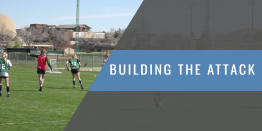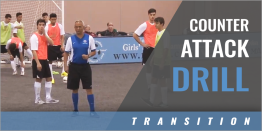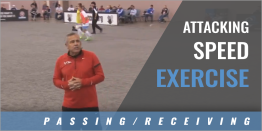| Successful Prevention Of a Serious Injury:
By: William E. Garrett, Jr., MD, Ph. D, Duke University Sports Medicine - A FIFA Medical Centre of Excellence Chairman; U.S. Soccer Sports Medicine Advisory Committee Originally Published in - The Soccer Journal - National Soccer Coaches Association of America  At a reunion of my (Don's) college team, a teammate commented on the modern player being more athletic than we were. I replied with the typical response of the learned Ph. D with an "I'm not so sure about that." While we might have had four or five good athletes, today's teams start 11 good athletes. Players certainly do cover more ground during a match today, but fitness tests show only modest improvements over the past decades. Longtime coaches who have watched the game change from the field level might disagree, but we both think that the biggest difference is in skill level. In college, we played at the pace that our skill allowed us to play (i.e. slower). Today, the skill level is so high that the game can be played at a much higher level. And that influences the physical aspect of the game that is different than in previous years: the pace of high-intensity work performed is greater today, but that also demands a bit more very low-paced work to recover. All this has another effect. In our day, the number-one injury was a sprained ankle, but today, the most common injury amongst high-level players (at least in males) is a hamstring strain. In our day, my college team had one hamstring strain over our four-year period. A professional team in Europe now can have six or more in a single season. The college team with three in a season probably thinks it's been a good year. The question is: How to do they happen? A hamstring strain is generally believed to occur during high-speed sprinting or as a result of a rapid change of direction. Humans have three hamstrings: the semitendinosis and semimembranosis run down the medial side of the posterior thigh and you can feel the two tendons behind your knee. The biceps femoris is the lateral hamstring and forms the shape of the lateral side of the posterior thigh. All three originate on the ischial tuberosity (that bony knot you sit on) and insert behind the knee. All three have two primary actions: flex the knee and extend the hip (raise your straight leg behind you). They each have some secondary actions for thigh rotation, adduction (move the thigh toward the midline) and abduction (away from the midline). For the most part, a strain injury occurs during the primary action, specifically during the eccentric (lengthening) phase when the hamstrings are keeping the knee from flexing. The sprinting player is trying to go just a little bit faster, or improve position on an opponent running right beside, and overstrides just enough so that when the lead foot strikes the ground and the hamstring is contracting eccentrically (while lengthening), the muscle can tear. Pain along the back of the thigh is immediate and intense, meaning that further play is highly unlikely. The extent of damage dictates the time lost. And the time lost is usually measured in weeks, not days. Practically speaking, a midseason hamstring strain in the short, match-dense season of the United States school or club season can be a season-ending injury. Between the bony origin and insertions are two distinct muscle and tendon tissues. The weak link is where the two tissues meet called the muscle-tendon junction. Neither a muscle belly nor healthy tendons are prone to tear during activity, but where these two distinct tissues connect is the weak link. So why can the pain be anywhere on the back of the thigh? That's an anatomy question. Tendon fibers are not all the same length and run deep into the muscle making the junction quite strong (sort of a muscle's version of a mortise and tenon joint). A tear can happen to any of those muscle-tendon units regardless of how far they extend into the muscle body; tendons' fibers aren't all the same length and don't all terminate at the "ends" of a muscle. Treatment is the standard rest, ice, compression and elevation. Crutches may be required in the early period of recovery. Once the pain subsides, the player may start some light movements, very low-level stretching, and the beginnings of some light resistance exercises before moving towards more functional movements. Pain medications may help with the discomfort, but there is no drug that will speed recovery. Some practitioners may advise a corticosteroid injection or, more recently, platelet enriched plasma (obtained from the patient's own blood); however, high-quality research studies have yet to validate the usefulness of these techniques. A physician and therapist should be guiding progression during recovery. Functional progressions are slow and the athlete will need to pass some tests to progress to the next stage of recovery. A continuing flow of information on the player's progress needs to be provided to the physician who makes the final return-to-play decision. Coming back too early greatly increases the risk of having a repeat injury; remember that an incompletely healed minor injury often precedes a more major injury, so players shouldn't be too eager to come back (which is easier said than done). The number of same-season recurrent hamstring strains is appalling. This could also mean that physicians need better and more objective information and criteria to determine when the muscle is fully healed, but that is another topic altogether. But here is the bottom line: many hamstring strains are preventable - both the initial injury (the index injury) and the subsequent injury (recurrent injury). Sports medicine researchers look for risk factors of injury: variables that say who is most likely to sustain a particular injury. The number one predictor of a hamstring strain (or most any injury for that matter) is a history of a prior injury. Had one hamstring strain? Your risk of a recurrent injury is increased by a factor of six to eight. That makes preventing the first injury pretty important. Another risk factor is strength, specifically eccentric strength. Muscles develop tension by shortening (concentrically) and when lengthening (eccentrically). Don't assume that the player with good concentric strength also has good eccentric strength. Athletes who have poor eccentric strength have far more hamstring strain injuries than those with good strength as do players with significant strength imbalances between the two legs. Don't forget that fatigue accentuates the importance of any risk factor; improved fitness prevents a host of injuries. There is mounting evidence that regular use of the "Nordic Hamstring" exercise is very effective at improving eccentric strength and preventing hamstring strains. This exercise is done in pairs. A partner anchors the feet to the ground while the other kneels. Keeping a straight line from the thighs through the hips, trunk, and head/neck, the player slowly leans forward until unable to control the descent and then catches their fall. Return to the start position and repeat. This should be performed each training day as well as off days, but not on match days. Follow the progression outlined by the FIFA 11+ injury prevention program where beginners try to do three to five repetitions. Once five can be completed over a substantial percentage of the full range of motion, move up to seven to 10 reps, then 12-15 reps. Other progressions also have been successful improvement is seen by being able to do more reps and by being able to control the descent closer and closer to the ground. We've seen videos of really strong players who get a gentle shove first to add more load and have even seen one player who was shoved toward the ground, controlled the descent to within a couple inches of the ground and reversed the movement back to the starting position. But that's not the only task. Flexibility training is considered a standard practice for preventing strain injury. But we've been hearing a lot of negative comments about static stretching and its inhibitory effects on high-power output exercise and the lack of proof that static stretching really does prevent injury. All that is true, so most teams do not do much static stretching before exercise, and especially not before a match. Static stretching still has a place, it's just not before training or competition. What static stretching is very good for is increasing the range of motion around a joint, so it is best if static stretching is done at a time separate from actual training or a match, such as while doing something a bit passive like watching TV or a video or even while chatting on the phone. Most research indicates holding the stretch for 30 seconds is effective, but one can find pro and con results for most any duration, as well as how long static stretching inhibits performance. On training or match days, it's best to use dynamic stretching as part of a well-structured warm-up. You should notice that FIFA 11+ has dynamic stretching exercises for the adductors. Now you can search YouTube for hundreds of examples, but the site I always refer soccer people to is by John Cone who has a strong academic (Ph. D) and practical (MLS) background. Go to ConeFitnessTraining.com and click on "Presentations," where you will find links to a whole series of dynamic flexibility videos including some for the hamstrings. Bookmark it and refer to it often. A further intervention that has proven to be successful is a series of dynamic one- and two-legged balance and jump/land exercises. Teams that implement some form of hamstring strain prevention as a regular aspect of each training session see a dramatic reduction in the number, rate, severity, and time lost to hamstring strain injury. For example, regular use of the Nordic Hamstring resulted in a 65-70% reduction in hamstring strain injury. A functional training program appears to minimize the impact of risk factors and when used on a small sample of Australian Rules football players, it resulted in a 72% reduction in hamstring strain injury Balance training reduced the rate of hamstring strains in professional female players by 60%8. Recurrent injuries can be more severe than the index injury (25 days lost vs. 17 days, respectively) As the hamstring originates on the pelvis, it's possible that there may be a core component to this injury as there is to a knee injury, but that has yet to be shown. All told, the coach really does have quite an arsenal of methods that have been shown to effectively reduce hamstring strains. As with all topics, there are conflicting views and the reason behind divergent findings is beyond the scope of this article. Opinions will continue to vary as research into this topic matures. True "evidence" like that expected for clinical trials of drugs to treat serious diseases may be lacking, but there is an evolving body or work that favors some form of intervention to prevent this serious strain injury. Every team has a warm-up routine and many routines may not be doing the players any favors. Why? This may be due to "historical inertia," which is a nice way of saying "that's the way we've always done it" and we continue to see warm-up routines with only a little static stretching as a meager attempt at helping the hamstrings. Every activity should have a purpose. So far, the options presented here surely do. The wise coach who wants to keep all players healthy for the entire season so they can continue to develop should include the Nordic Hamstring exercise and dynamic flexibility as a part of their routine warm-up for training and should strongly encourage players to do static stretching at home. Or follow the FIFA 11+ as it contains all the elements described here. The coach who says, "I've never had a player with a hammy" is a bit like the motorcyclist who doesn't wear a helmet. It's not a matter of if they will lay their bike down; it's a matter of when.
|






